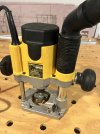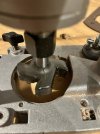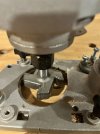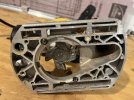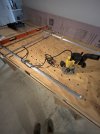I have been putting together a router slab flatting setup - like the ones where the you have a router mounted to a plate and it runs on rails (see photo).
I got a good quality 2 inch surfacing router bit. I have been doing some preliminary setup, and installed the bit with a 1/2” collet into my 2hp DW621.
With the bit installed, Im concerned I’m pushing the limits of what is safe with this router. I had to take the plastic dust collection piece off to get it in place, which is not a big deal I guess, I’m a little concerned at how close the edge of the bit is to the router baseplate/body. Of course it will be below this during milling, but nevertheless it catches the eye.
I’m also trying to figure out the best way to mount the router base to the plate that runs on the rails I have - doesn’t seem to be many great threaded screw holes in the base to work with.
Perhaps I am being overly cautious - I have not used such a big bit in my router before. Appreciate the thoughts or experiences you all may have.
I got a good quality 2 inch surfacing router bit. I have been doing some preliminary setup, and installed the bit with a 1/2” collet into my 2hp DW621.
With the bit installed, Im concerned I’m pushing the limits of what is safe with this router. I had to take the plastic dust collection piece off to get it in place, which is not a big deal I guess, I’m a little concerned at how close the edge of the bit is to the router baseplate/body. Of course it will be below this during milling, but nevertheless it catches the eye.
I’m also trying to figure out the best way to mount the router base to the plate that runs on the rails I have - doesn’t seem to be many great threaded screw holes in the base to work with.
Perhaps I am being overly cautious - I have not used such a big bit in my router before. Appreciate the thoughts or experiences you all may have.

